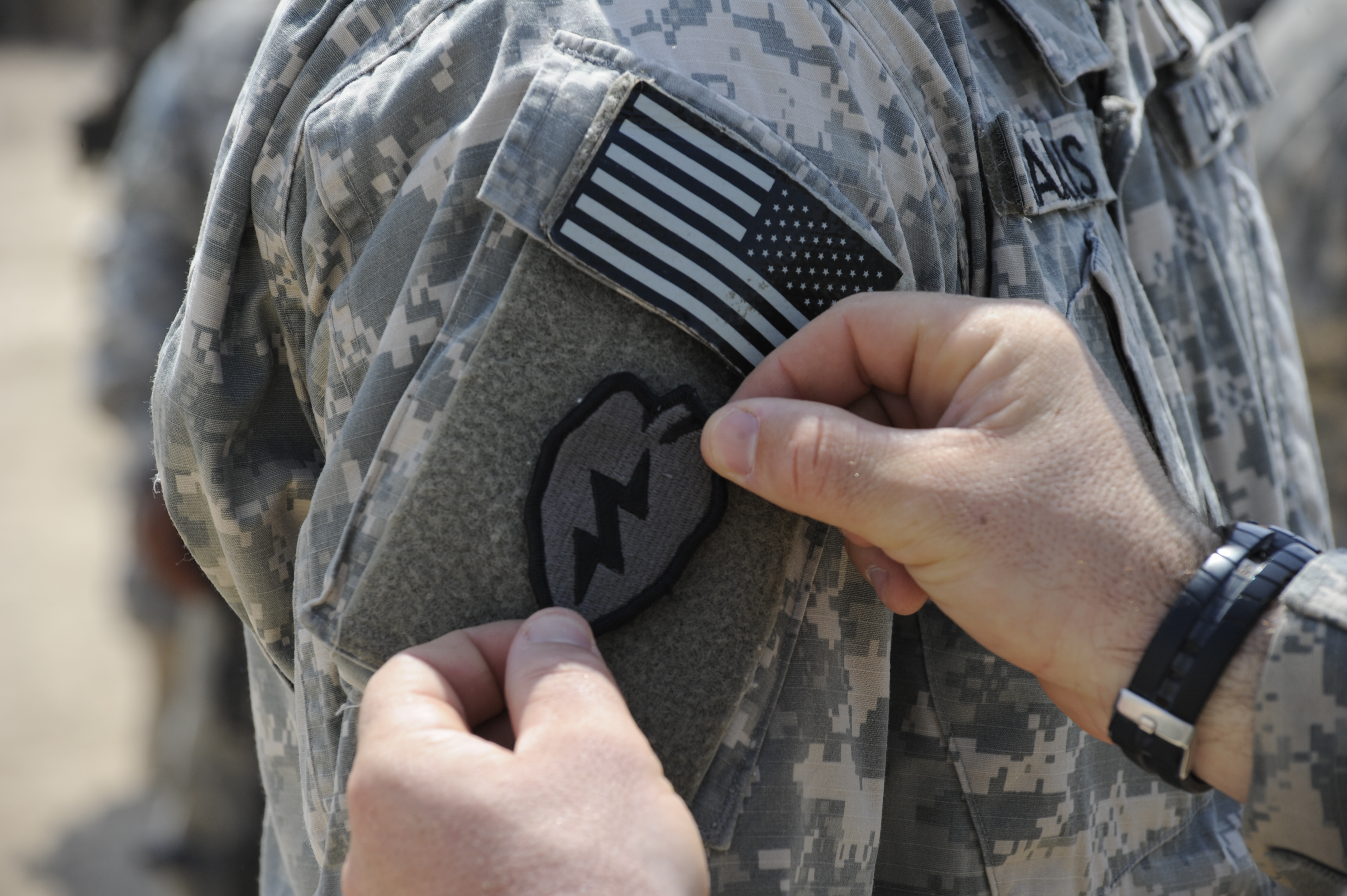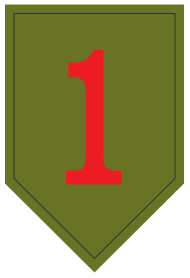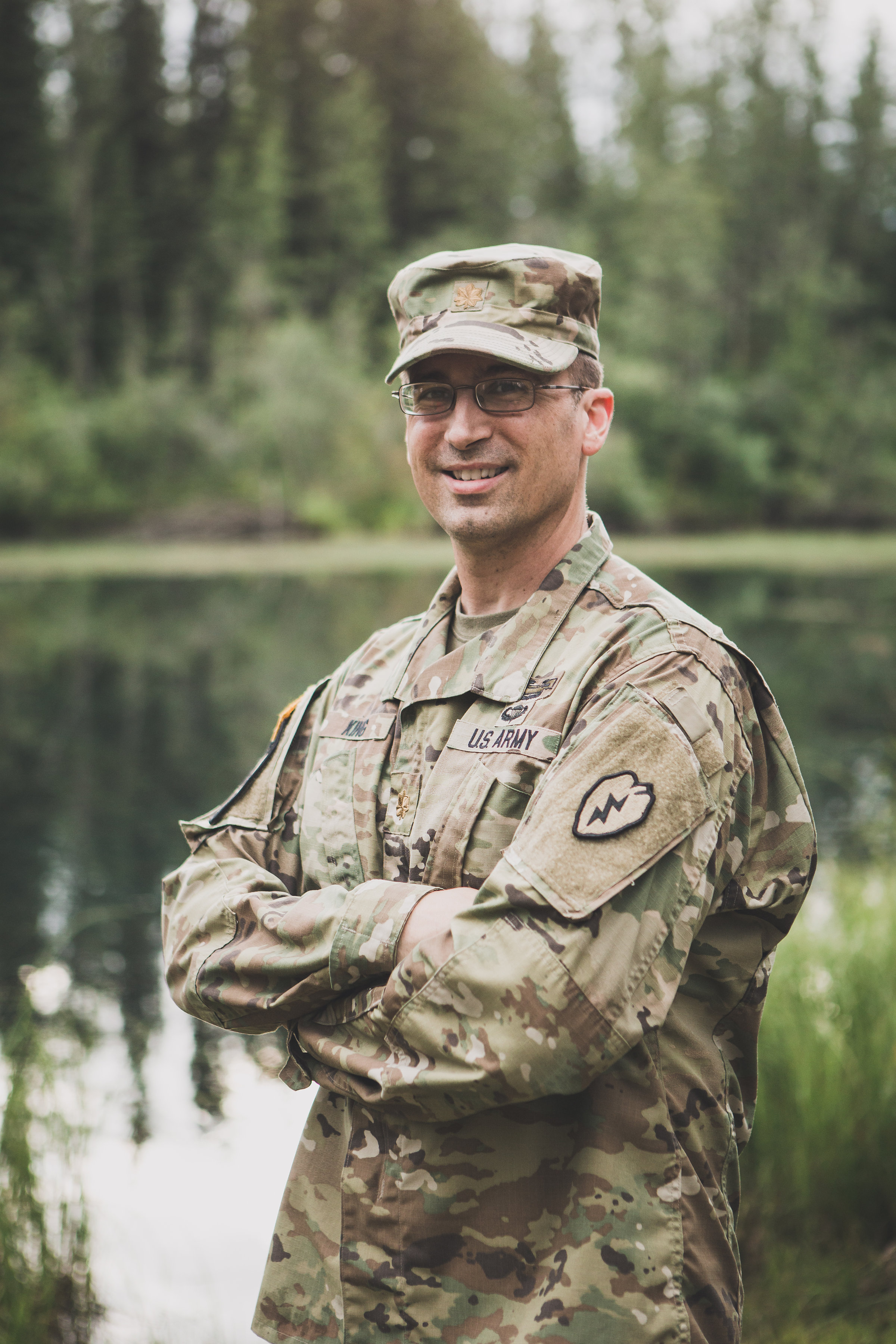The 101st has the Screaming Eagle. The 82nd has All American. The 25th the Electric Strawberry, and the 1st Infantry Division the Big Red One. Each of these historic units, along with many other active duty units, have very distinct shoulder sleeve patches worn with pride on a Soldier’s left arm. Pride from knowing that they were sharing history with “the Band of Brothers” or the Dough Boys that battled across France. While many National Guard units’ patches have storied histories – New York National Guard’s 42nd Infantry Division and their exploits during World War I and II come to mind – few instill the same amount of pride as those worn by active-duty soldiers.
Recently, as a part an Army pilot program to bring together Active Duty, Reserve and National Guard units, units from across the three components performed what has been called “patch-over” ceremonies. In these ceremonies National Guard and Reserve units removed their unit patch and put on the patch of the Active Duty unit they were partnering with. It’s crucial to the success of this program, known as the Army’s Associated Unit pilot program, for this new tradition to continue.
As a member of the Washington Army National Guard in the mid-90s, my unit, the 81st Infantry Brigade, wore a patch consisting of a white square with a Native American raven on the inside. The unit patch on its own had no real history, no iconic moment that someone could turn to and say, “I’m a part of the unit that fought in this great battle”. No one outside of the states on the West Coast had ever even seen a patch like it. While at basic training my fellow recruits would talk about how excited they were to be going to a historic unit like the 101st or 82nd Airborne. I could only listen and smile, secretly wishing my unit was as famous as theirs.
At the time, my brigade was considered a “round out” brigade. If war broke out in Korea, the 81st Infantry Brigade was assigned to “round out” the 2nd Infantry Division. The relationship existed on paper only. No one from 2ID actually partnered with us. No one came to our training events and no one ever thought to have us wear the 2nd Infantry Division’s patch, a Native American in full headdress superimposed on a star and shield with a history in WWI, WWII and Korea. We were alone and unafraid, fighting mock battles at the Yakima Training Center attempting to make the high desert feel like North Korea. We were not really a part of the 2ID team.
Later I wrote off my desire to wear a different patch to youthful ignorance. It didn’t matter what you wore on your sleeve. It was the people in the unit that made it great, not a symbol on your arm, right? Sure it helped that a unit had a strong past that leaders and soldiers could look to for inspiration. But a true measure of a unit was supposed to be “what have you done for me lately?” not what did you do 50 or 75 years ago. It wasn’t until twelve years later that I truly understood the power a unit patch really had.
In 2007, my first assignment out of the Military Intelligence Captain’s Career Course was as an Intelligence Advisor on a Military Transition Team. These teams, known as a MiTTs were assigned to, and trained by, the 1st Brigade of the 1st Infantry Division before being sent to Iraq or Afghanistan. This affiliation with 1ID required us to wear the distinctive unit patch of the Big Red One, one of the most storied units in the Army.
After the train up, my team was sent to Iraq to work with an Iraqi Army Battalion outfitted with BTR-80s. Once in theater my 10-person MiTT was tasked with training our host nation army unit while partnering with the U.S. Army brigade we shared battle space with. During the course of that year in Iraq we partnered with three U.S. Army brigades.
Two of these brigades actively encouraged us to trade in our Big Red One patch for their unit’s patch in order to truly be a part of their team. This act created instant recognition and support when we went to ask for help. It also created a sense of ownership for the supporting unit commander. It’s one thing for a team that just happens to be working in the same area to fail. It’s quite another for a unit identified as being a part of your team to fail. A commander is quicker to assist someone they see as part of their team than someone who isn’t. One of those units was so inclusive that I later fought to be assigned to it as my next duty assignment when I returned from Iraq. A unit that turned out to be the best unit I have ever been a part of.
One unit, however, made it clear that we were not welcome to wear their historic patch. We were not a part of their team and it was clear we never would be. A unit I would fight tooth and nail to avoid in the future.
This made our job extremely difficult. We had moved our Iraqi Battalion halfway across the country into a major city that none of us knew anything about and now we had to fend for ourselves. Fortunately, we only spent the last month and a half of our deployment with them. For a ten-person team having to operate on their own, it made that last month and a half in Iraq easily the hardest of the entire deployment.
In the Army, relationships are everything. The symbolic sharing of unit patches is a great first step in building a solid relationship between units. These ceremonies, which are unique to Army units, should be continued in order to foster a one team atmosphere. As the Army’s Associated Unit Program grows to create permanent partnerships between Active Duty, National Guard, and Army Reserve units, consideration should be made towards making these patch change overs official. This sharing of patches across the Army components will go a long way to strengthen the Army’s total force structure.






I have to consede that “the bird in the tennis shoe” and others do fall short of those units above. But there is a story in the regiments below that is just as storied and longer. We as a force will never have a workable “ATFP” if we can’t get to the point that “patches” must to swap both ways.
David – first step in that direction: “The 3rd Brigade Combat Team, 10th Mountain Division, stationed in Fort Polk, Louisiana, will be associated with the Texas Army National Guard’s 36th Infantry Division.”
Excellent article on esprit de corps! For more on current SSI, see, e.g., http://www.tioh.hqda.pentagon.mil/Catalog/HeraldryList.aspx?CategoryId=22&grp=2&menu=Uniformed%20Services
This will just reduce the pride in wearing the patch. Part of the Trophies to everyone generation.
Charlie – Fully agree! I’ve been fortunate to be involved with two storied units, the 27th DIV (BDE) and the 42nd DIV. I’m sorry for the author who feels his unit is unworthy of respect. While I respect the active duty units I’ve been involved with, I have proudly worn the “broken battle ax” and the “half-rainbow” because I’ve studied their histories. I know the battles fought in two world wars and the Medals of Honor earned for both units. I know of the multiple deployments served in Afghanistan, Iraq, etc. and the sacrifice of those National Guardsmen. These are the same men and women who have responded to snow storms, hurricanes and floods across out country.
As there are numerous Active Duty units with rather short lineages, the author is correct – lets have a re-patching – let those “lesser” active duty units wear our patches and maybe they’ll understand what its like to serve nation and state.
RF,
Right there with you, the pride that comes from any unit’s patch consists of that unit’s particular leadership, unit camaraderie, specific SOPs, and being part of a brotherhood. I.e. if you didn’t go through RIP or RAP, and weren’t assigned with pin point orders to the 75th and deployed with them? Then guess what? you aren’t wearing that coveted scroll on your right shoulder.
Essentially this so called “patch-over” concept is a ridiculous notion to allow the not so cool kids to be, well, part of the in crowd. Except the in crowd lives, trains, deploys, and fights together from places like Campbell, Bragg, or Benning. The in crowd signs up and competes to serve and fight FULL time. They give 24 hrs a day, 7 days a week, 365 day a year to the Army till either retire or fulfill their contract.
Yet some “Guard” supply SGT who is too ashamed to wear his rainbow patch wants the eighty duce or whatever “cool” tradition they want to buy in with out paying the appropriate price.
The worse part is the erosion of the pride associated with that national guard unit’s patch. With all these guard unit deployments that particular state should build a proud heritage instead of throwing their patch away to feel “good” and build on someone else’s legacy.
Current Active Duty, proudly earned 4th ID, SOCCENT, and 5SFG(A) as an organic member.
@ Mike “Full Timer” Jay
You do know Guard Units have active duty AGR guys and gals who give their whole lives just like you did 24/7-365. Just saying. Maybe you should get better informed before you get on that high horse. I fought in Iraq and Afghanistan, while also being there for my state with protests, fires, floods, etc. The truth is most Active Duty guys usually hate their lives and aren’t well rounded.
I enjoyed the bit of information but can’t believe you left off the Famed 32nd Infantry Division. Not only did it have a proven combat record, it is (or at least was) The Wisconsin National Guard. That’s where I got my start (WMA) which lead to my active duty and eventual retirement from the Regular Army. But thanks for the info. Ltc. Vern “Whitey” Hansen Army Retired
In the 80’s several of the “round out” brigades (48th BDE in particular) wore both their own brigade patch on the shoulder and the affiliated division (24th ID) on the BDU pocket. I always thought this a nice compromise; though it was not really practical for units affiliated with 1 CD or 2 ID.
To be honest, and I might be alone in this, but I’m proud, yes PROUD, of my raven patch (81st HBCT). It may not have the WWI/II associations that the big red one or 2ID have, but it’s the patch of MY state, my home. The raven patch doesn’t just represent where I drill, it represents my state’s heritage, its history, and culture.
There’s no culture of 2ID but that of 2ID. But the culture of the 81st is the culture of the Pacific Northwest, and of all its people, not just those who served under it.
In my opinion, this “re-patching” is a way to minimize the importance and relevance of the National Guard units in an army where the Active component is increasingly being pressured to justify it’s full-time existence. The National Guard doesn’t need partnering with active units, but the Active units clearly are vying for resources.
With respect, I don’t think you ever fully appreciated what the guard represents, and instead opted to daydream about being “one of those cool active duty guys”.
Fellow Troops,
You each have a unit, battalion, or brigade that each and every unit is assigned be proud of that and this
they represent the state unit and are the upper Command element to the Active component.
But like many of you, ive been both guard/ active duty
I think both have their place and history. But having
Said, that my time in the guard far out weigh my time in active. The friendships , the group tightness is far more inclusive.
The active side you have friends for a while then they
Transfer , reassigned or just got out. Don't git me wrong imet my wife thru her cousin on active duty
and wouldn't trade any of that.
But the bottom line is it's what you make it! So be proud no matter where you served? Both ways are part of our nation and branch of service.
“One day he visited the 444th QM Truck Company, an outstanding all-Negro outfit attached to the 4th Armored for about a year. When these men with the 444th markings barreled their bullet-holed trucks into the depots for resupply, they were waived to the head of the line. It was known that they were the lifeline to Patton’s spearhead 4th Armored and they often had to shoot their way forward through great patches of enemy territory cut off in the wake of the 4th. Because of their good work, the division commander had allowed them to wear the shoulder patch of the 4th Armored.
As Clarke inspected these troops lined up on parade, he saw that some men had the 4th Armored patches on their right shoulder. He snapped at one soldier, “Don’t you know regulations? Your patch belongs on your left shoulder.”
“General, sir, the ones of us with the patch on the right sleeve are the assistant drivers. That way the patch shows out the right cab window.” Clarke grinned, “That’s the way I want it; don’t let anyone change it.”
General Bruce C. Clarke in June 1945 as the post V.E. day C.G. of the 4th Armored Division from:
“Clarke of St. Vith: The Sergeants’ General”
Dillion/Liederbach, Inc.
Pgs.: 144-145